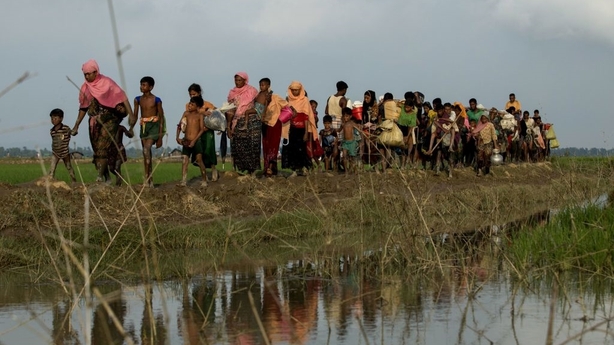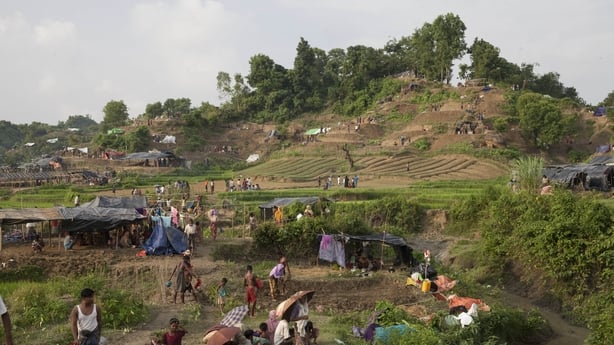Myanmar's de facto leader Aung San Suu Kyi has alleged a "huge iceberg of misinformation" was distorting the picture of the Rohingya crisis, which has forced 125,000 of the Muslim minority to flee to Bangladesh.
In her first comments since Rohingya militant attacks sparked unrest on 25 August, Ms Suu Kyi was quoted by her State Counsellor's office as saying fake news was "calculated to create a lot of problems between different communities" and to promote "the interest of the terrorists".
An army crackdown triggered by an attack on 25 August by Rohingya militants on Myanmar security forces has led to the killing of at least 400 people and the exodus of nearly 125,000 Rohingya to neighbouring Bangladesh, leading to a major humanitarian crisis.
According to two Bangladeshi government sources, Myanmar has been laying landmines along a section of its border with Bangladesh for the past three days.
RTÉ Special Report: Crisis in Myanmar
They suggest their purpose may be to prevent the return of Rohingya Muslims fleeing violence.
Bangladesh is expected to formally lodge a protest today against the laying of land mines so close to the border.

"They are putting the landmines in their territory along the barbed-wire fence" between a series of border pillars, said one of the sources.
Both sources said Bangladesh learned about the landmines mainly through photographic evidence and informers.

"Our forces have also seen three to four groups working near the barbed wire fence, putting something into the ground," one of the sources said. "We then confirmed with our informers that they were laying land mines."
The sources did not clarify if the groups were in uniform, but added that they were sure they were not Rohingya insurgents.
Manzurul Hassan Khan, a Bangladesh border guard officer, earlier told the Reuters news agency that two blasts were heard on Tuesday on the Myanmar side, after two on Monday fuelled speculation that Myanmar forces had laid land mines.
One boy had his left leg blown off yesterday near a border crossing before being brought to Bangladesh for treatment, while another boy suffered minor injuries, Mr Khan said, adding that the blast could have been a mine explosion.
A Rohingya refugee who went to the site of the blast on Monday filmed what appeared to be a mine - a metal disc about ten centimetres in diameter partially buried in the mud.
He said he believed there were two more such devices buried in the ground.
Two refugees also told Reuters they saw members of the Myanmar army around the site in the immediate period preceding the Monday blasts.
Reuters was unable to independently verify that the planted devices were land mines and that there was any link to the Myanmar army.
The Myanmar army has not commented on the blasts near the border.
The border pillars mentioned by the Dhaka-based sources demarcate the boundaries of the two countries, along which Myanmar has a portion of barbed wire fencing.
Most of the two countries' 217km long border is porous.
"They are not doing anything on Bangladeshi soil," said one of the sources. "But we have not seen such laying of land mines before."
Myanmar, which was under military rule until recently and is one of the most heavily-mined countries in the world, is one of the few countries that have not signed the 1997 UN Mine Ban Treaty.

